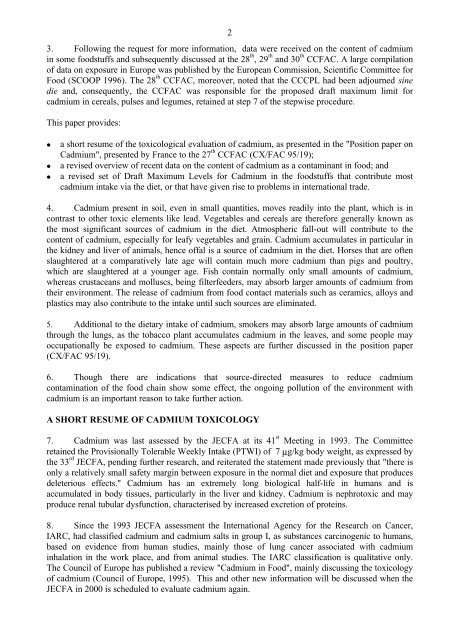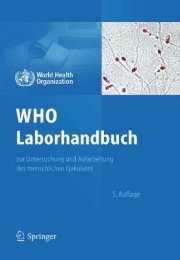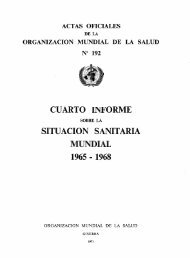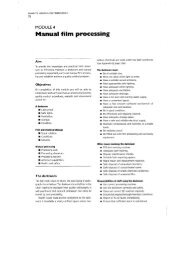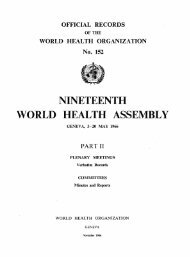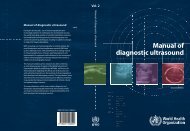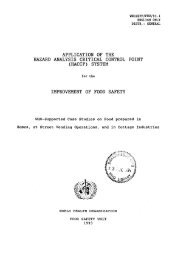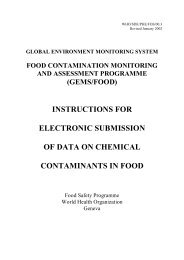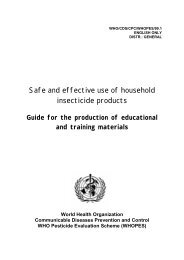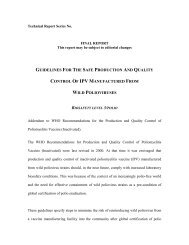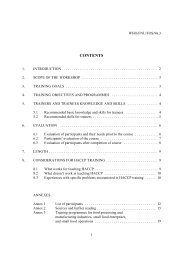CX/FAC 99/21 - World Health Organization
CX/FAC 99/21 - World Health Organization
CX/FAC 99/21 - World Health Organization
Create successful ePaper yourself
Turn your PDF publications into a flip-book with our unique Google optimized e-Paper software.
2<br />
3. Following the request for more information, data were received on the content of cadmium<br />
in some foodstuffs and subsequently discussed at the 28 th , 29 th and 30 th CC<strong>FAC</strong>. A large compilation<br />
of data on exposure in Europe was published by the European Commission, Scientific Committee for<br />
Food (SCOOP 1<strong>99</strong>6). The 28 th CC<strong>FAC</strong>, moreover, noted that the CCCPL had been adjourned sine<br />
die and, consequently, the CC<strong>FAC</strong> was responsible for the proposed draft maximum limit for<br />
cadmium in cereals, pulses and legumes, retained at step 7 of the stepwise procedure.<br />
This paper provides:<br />
• a short resume of the toxicological evaluation of cadmium, as presented in the "Position paper on<br />
Cadmium", presented by France to the 27 th CC<strong>FAC</strong> (<strong>CX</strong>/<strong>FAC</strong> 95/19);<br />
• a revised overview of recent data on the content of cadmium as a contaminant in food; and<br />
• a revised set of Draft Maximum Levels for Cadmium in the foodstuffs that contribute most<br />
cadmium intake via the diet, or that have given rise to problems in international trade.<br />
4. Cadmium present in soil, even in small quantities, moves readily into the plant, which is in<br />
contrast to other toxic elements like lead. Vegetables and cereals are therefore generally known as<br />
the most significant sources of cadmium in the diet. Atmospheric fall-out will contribute to the<br />
content of cadmium, especially for leafy vegetables and grain. Cadmium accumulates in particular in<br />
the kidney and liver of animals, hence offal is a source of cadmium in the diet. Horses that are often<br />
slaughtered at a comparatively late age will contain much more cadmium than pigs and poultry,<br />
which are slaughtered at a younger age. Fish contain normally only small amounts of cadmium,<br />
whereas crustaceans and molluscs, being filterfeeders, may absorb larger amounts of cadmium from<br />
their environment. The release of cadmium from food contact materials such as ceramics, alloys and<br />
plastics may also contribute to the intake until such sources are eliminated.<br />
5. Additional to the dietary intake of cadmium, smokers may absorb large amounts of cadmium<br />
through the lungs, as the tobacco plant accumulates cadmium in the leaves, and some people may<br />
occupationally be exposed to cadmium. These aspects are further discussed in the position paper<br />
(<strong>CX</strong>/<strong>FAC</strong> 95/19).<br />
6. Though there are indications that source-directed measures to reduce cadmium<br />
contamination of the food chain show some effect, the ongoing pollution of the environment with<br />
cadmium is an important reason to take further action.<br />
A SHORT RESUME OF CADMIUM TOXICOLOGY<br />
7. Cadmium was last assessed by the JECFA at its 41 st Meeting in 1<strong>99</strong>3. The Committee<br />
retained the Provisionally Tolerable Weekly Intake (PTWI) of 7 μg/kg body weight, as expressed by<br />
the 33 rd JECFA, pending further research, and reiterated the statement made previously that "there is<br />
only a relatively small safety margin between exposure in the normal diet and exposure that produces<br />
deleterious effects." Cadmium has an extremely long biological half-life in humans and is<br />
accumulated in body tissues, particularly in the liver and kidney. Cadmium is nephrotoxic and may<br />
produce renal tubular dysfunction, characterised by increased excretion of proteins.<br />
8. Since the 1<strong>99</strong>3 JECFA assessment the International Agency for the Research on Cancer,<br />
IARC, had classified cadmium and cadmium salts in group I, as substances carcinogenic to humans,<br />
based on evidence from human studies, mainly those of lung cancer associated with cadmium<br />
inhalation in the work place, and from animal studies. The IARC classification is qualitative only.<br />
The Council of Europe has published a review "Cadmium in Food", mainly discussing the toxicology<br />
of cadmium (Council of Europe, 1<strong>99</strong>5). This and other new information will be discussed when the<br />
JECFA in 2000 is scheduled to evaluate cadmium again.


